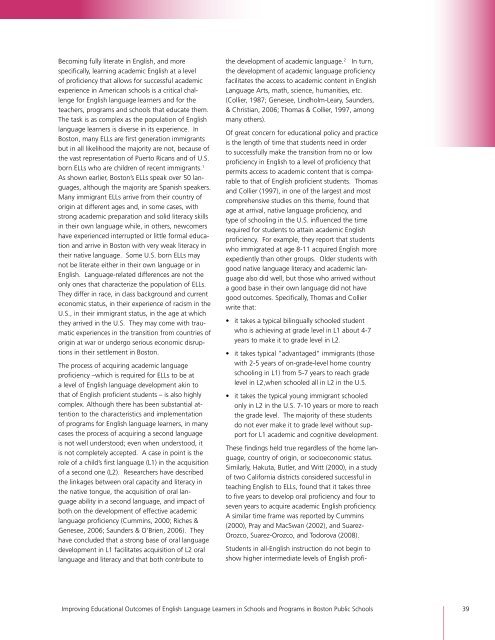Full Report - Center for Collaborative Education
Full Report - Center for Collaborative Education
Full Report - Center for Collaborative Education
You also want an ePaper? Increase the reach of your titles
YUMPU automatically turns print PDFs into web optimized ePapers that Google loves.
Becoming fully literate in English, and more<br />
specifically, learning academic English at a level<br />
of proficiency that allows <strong>for</strong> successful academic<br />
experience in American schools is a critical challenge<br />
<strong>for</strong> English language learners and <strong>for</strong> the<br />
teachers, programs and schools that educate them.<br />
The task is as complex as the population of English<br />
language learners is diverse in its experience. In<br />
Boston, many ELLs are first generation immigrants<br />
but in all likelihood the majority are not, because of<br />
the vast representation of Puerto Ricans and of U.S.<br />
born ELLs who are children of recent immigrants. 1<br />
As shown earlier, Boston’s ELLs speak over 50 languages,<br />
although the majority are Spanish speakers.<br />
Many immigrant ELLs arrive from their country of<br />
origin at different ages and, in some cases, with<br />
strong academic preparation and solid literacy skills<br />
in their own language while, in others, newcomers<br />
have experienced interrupted or little <strong>for</strong>mal education<br />
and arrive in Boston with very weak literacy in<br />
their native language. Some U.S. born ELLs may<br />
not be literate either in their own language or in<br />
English. Language-related differences are not the<br />
only ones that characterize the population of ELLs.<br />
They differ in race, in class background and current<br />
economic status, in their experience of racism in the<br />
U.S., in their immigrant status, in the age at which<br />
they arrived in the U.S. They may come with traumatic<br />
experiences in the transition from countries of<br />
origin at war or undergo serious economic disruptions<br />
in their settlement in Boston.<br />
The process of acquiring academic language<br />
proficiency –which is required <strong>for</strong> ELLs to be at<br />
a level of English language development akin to<br />
that of English proficient students – is also highly<br />
complex. Although there has been substantial attention<br />
to the characteristics and implementation<br />
of programs <strong>for</strong> English language learners, in many<br />
cases the process of acquiring a second language<br />
is not well understood; even when understood, it<br />
is not completely accepted. A case in point is the<br />
role of a child’s first language (L1) in the acquisition<br />
of a second one (L2). Researchers have described<br />
the linkages between oral capacity and literacy in<br />
the native tongue, the acquisition of oral language<br />
ability in a second language, and impact of<br />
both on the development of effective academic<br />
language proficiency (Cummins, 2000; Riches &<br />
Genesee, 2006; Saunders & O’Brien, 2006). They<br />
have concluded that a strong base of oral language<br />
development in L1 facilitates acquisition of L2 oral<br />
language and literacy and that both contribute to<br />
the development of academic language. 2 In turn,<br />
the development of academic language proficiency<br />
facilitates the access to academic content in English<br />
Language Arts, math, science, humanities, etc.<br />
(Collier, 1987; Genesee, Lindholm-Leary, Saunders,<br />
& Christian, 2006; Thomas & Collier, 1997, among<br />
many others).<br />
Of great concern <strong>for</strong> educational policy and practice<br />
is the length of time that students need in order<br />
to successfully make the transition from no or low<br />
proficiency in English to a level of proficiency that<br />
permits access to academic content that is comparable<br />
to that of English proficient students. Thomas<br />
and Collier (1997), in one of the largest and most<br />
comprehensive studies on this theme, found that<br />
age at arrival, native language proficiency, and<br />
type of schooling in the U.S. influenced the time<br />
required <strong>for</strong> students to attain academic English<br />
proficiency. For example, they report that students<br />
who immigrated at age 8-11 acquired English more<br />
expediently than other groups. Older students with<br />
good native language literacy and academic language<br />
also did well, but those who arrived without<br />
a good base in their own language did not have<br />
good outcomes. Specifically, Thomas and Collier<br />
write that:<br />
• it takes a typical bilingually schooled student<br />
who is achieving at grade level in L1 about 4-7<br />
years to make it to grade level in L2.<br />
• it takes typical “advantaged” immigrants (those<br />
with 2-5 years of on-grade-level home country<br />
schooling in L1) from 5-7 years to reach grade<br />
level in L2,when schooled all in L2 in the U.S.<br />
• it takes the typical young immigrant schooled<br />
only in L2 in the U.S. 7-10 years or more to reach<br />
the grade level. The majority of these students<br />
do not ever make it to grade level without support<br />
<strong>for</strong> L1 academic and cognitive development.<br />
These findings held true regardless of the home language,<br />
country of origin, or socioeconomic status.<br />
Similarly, Hakuta, Butler, and Witt (2000), in a study<br />
of two Cali<strong>for</strong>nia districts considered successful in<br />
teaching English to ELLs, found that it takes three<br />
to five years to develop oral proficiency and four to<br />
seven years to acquire academic English proficiency.<br />
A similar time frame was reported by Cummins<br />
(2000), Pray and MacSwan (2002), and Suarez-<br />
Orozco, Suarez-Orozco, and Todorova (2008).<br />
Students in all-English instruction do not begin to<br />
show higher intermediate levels of English profi-<br />
Improving <strong>Education</strong>al Outcomes of English Language Learners in Schools and Programs in Boston Public Schools 39


